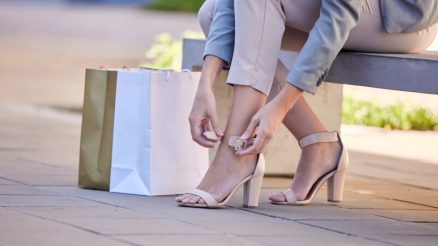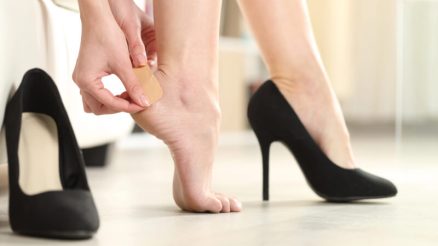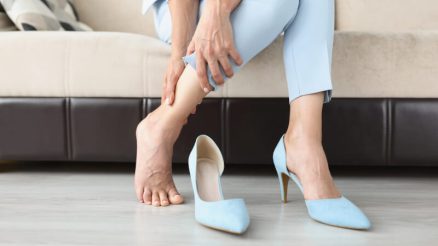We’ve all been there. You had a fantastic night out – dancing, mingling, and maybe even a little too much standing in those fabulous (but unforgiving) shoes. The next morning, however, your feet, particularly your heels, are screaming in protest. While a sore head might be a temporary inconvenience, lingering heel pain can put a real damper on your day.
But fear not! You don’t have to suffer in silence. Often, that post-night-out heel pain is due to a combination of factors: prolonged standing, unsupportive footwear, and even dehydration. The good news is that a few simple, gentle exercises can work wonders in relieving that discomfort and getting you back on your feet (literally!).
Here are some effective exercises you can do from the comfort of your home to soothe those aching heels:
1. The Classic Calf Stretch
Tight calf muscles can directly contribute to heel pain, especially if you’ve been wearing shoes with even a slight heel. Stretching them out can provide significant relief.
- How to do it:
- Stand facing a wall, about arm’s length away.
- Place your hands on the wall at shoulder height.
- Step one foot back, keeping your heel on the ground and your leg straight.
- Bend your front knee slowly, leaning into the stretch until you feel a pull in the calf of your back leg.
- Hold for 20−30 seconds.
- Repeat 2−3 times per leg.
- For a deeper stretch, you can slightly bend the back knee to target the lower calf muscle.
2. Plantar Fascia Stretch (Towel Stretch)
The plantar fascia is a thick band of tissue that runs along the bottom of your foot, connecting your heel bone to your toes. When it gets inflamed, it causes that sharp heel pain.
- How to do it:
- Sit on the floor with your legs extended in front of you.
- Loop a towel around the ball of one foot.
- Gently pull the towel towards you, keeping your leg straight, until you feel a good stretch along the arch of your foot and in your heel.
- Hold for 20−30 seconds.
- Repeat 2−3 times per foot.
3. Foot Rolling with a Ball
This is a fantastic way to self-massage your plantar fascia and release tension.
- How to do it:
- Sit in a chair and place a tennis ball (or a golf ball for a deeper massage) under the arch of your affected foot.
- Gently roll the ball back and forth from your toes to your heel, applying light pressure.
- If you find a particularly tender spot, hold the pressure there for 15−20 seconds before continuing to roll.
- Continue for 1−2 minutes per foot.
4. Toe Curls and Marbles
These exercises help strengthen the intrinsic muscles of your feet, which can provide better support for your arches and heels.
- Toe Curls:
- Sit in a chair with your feet flat on the floor.
- Curl your toes as if you’re trying to pick up a towel with them, then release.
- Repeat 10−15 times per foot.
- Marbles:
- Scatter about 10−15 marbles (or small similar objects) on the floor in front of you.
- Using only your toes, pick up each marble one by one and place it into a cup.
- Repeat with the other foot. This might feel awkward at first, but it’s very effective!
5. Achilles Tendon Stretch
The Achilles tendon connects your calf muscles to your heel bone. A tight Achilles can also contribute to heel discomfort.
- How to do it:
- Stand on a step or curb with the balls of your feet on the edge and your heels hanging off.
- Slowly lower your heels down below the level of the step until you feel a stretch in your Achilles tendon and calf.
- Hold for 15−20 seconds.
- Repeat 2−3 times.
Important Tips for Recovery:
- R.I.C.E. Principle: For acute pain, remember R.I.C.E. – Rest, Ice (apply ice to the affected heel for 15−20 minutes at a time), Compression (a gentle wrap can help), and Elevation.
- Supportive Footwear: Give your feet a break from high heels or unsupportive flats. Opt for shoes with good arch support and cushioning.
- Stay Hydrated: Dehydration can contribute to muscle cramps and overall soreness. Drink plenty of water.
- Listen to Your Body: If any exercise causes sharp or increasing pain, stop immediately. It’s better to rest and consult a healthcare professional if the pain persists.
While these exercises can offer significant relief from typical post-night-out heel pain, persistent or severe pain might indicate a more serious condition like plantar fasciitis or a stress fracture. If your pain doesn’t improve after a few days of these exercises and rest, or if it worsens, please consult a doctor or a physical therapist for a proper diagnosis and treatment plan.
Don’t let a fun night out turn into days of discomfort. Incorporate these simple exercises into your morning-after routine, and you’ll be ready to hit the town again in no time!








